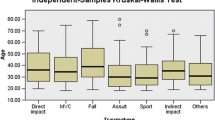Abstract
The aim of this study was to investigate the utility of repeat head CT in a large population of patients with non-isolated blunt mild head trauma (MTBI), especially in the presence of intracranial injury. This is a study of a cohort of 478 non-isolated MTBI patients admitted to the High Dependency Unit of the Emergency Department of the University-Hospital of Florence from July 2008 to December 2013. Results of initial and subsequent head CT scans, and indications for repeat head CT scan (routine vs. neurologic change) were recorded. The study population was divided into two subgroups: 28 (6 %) patients with neurological change or persistently reduced GCS (group GCS−) and 450 (94 %) patients with normal or improving GCS (group GCS+). After 6 months from the event, a telephone interview using SF12 questionnaire was conducted. Among GCS− patients, the admission CT scan showed intracranial lesions (ICI) in 16 (57 %) patients; only two patients had a TBI-related neurosurgical intervention. Among GCS+ patients, the first CT scan showed an ICI in 133 patients; in a significant proportion of patients with ICI at the first CT scan, the injury worsened (40/133, 30 %, p < 0.0001). However, no GCS+ patient had any neurosurgical intervention. We observed a significant reduction in both MCS and PCS scores after the injury compared with the previous period. The number of repeat CT scan was high in patients who presented ICI at the first CT scan; however, no patient with ICI and normal or improving GCS score needed a neurosurgical intervention.




Similar content being viewed by others
References
Cassidy JD, Carroll LJ, Peloso PM, Borg J, von HH, Holm L, Kraus J, Coronado VG (2004) Incidence, risk factors and prevention of mild traumatic brain injury: results of the WHO Collaborating Centre Task Force on Mild Traumatic Brain Injury. J Rehabil Med 28–60
Cassidy JD, Cancelliere C, Carroll LJ, Cote P, Hincapie CA, Holm LW, Hartvigsen J, Donovan J, Nygren-de BC, Kristman VL, Borg J (2014) Systematic review of self-reported prognosis in adults after mild traumatic brain injury: results of the International Collaboration on Mild Traumatic Brain Injury Prognosis. Arch Phys Med Rehabil 95:S132–S151
Reljic T, Mahony H, Djulbegovic B, Etchason J, Paxton H, Flores M, Kumar A (2014) Value of repeat head computed tomography after traumatic brain injury: systematic review and meta-analysis. J Neurotrauma 31:78–98
Sifri ZC, Homnick AT, Vaynman A, Lavery R, Liao W, Mohr A, Hauser CJ, Manniker A, Livingston D (2006) A prospective evaluation of the value of repeat cranial computed tomography in patients with minimal head injury and an intracranial bleed. J Trauma 61:862–867
Brown CV, Zada G, Salim A, Inaba K, Kasotakis G, Hadjizacharia P, Demetriades D, Rhee P (2007) Indications for routine repeat head computed tomography (CT) stratified by severity of traumatic brain injury. J Trauma 62:1339–1344
Stippler M, Smith C, McLean AR, Carlson A, Morley S, Murray-Krezan C, Kraynik J, Kennedy G (2012) Utility of routine follow-up head CT scanning after mild traumatic brain injury: a systematic review of the literature. Emerg Med J 29:528–532
Ulvik A, Kvale R, Wentzel-Larsen T, Flaatten H (2008) Quality of life 2–7 years after major trauma. Acta Anaesthesiol Scand 52:195–201
Innocenti F, Del TB, Coppa A, Trausi F, Conti A, Zanobetti M, Pini R (2015) Quality of life after mild to moderate trauma. Injury 46:902–908
Beseoglu K, Roussaint N, Steiger HJ, Hanggi D (2013) Quality of life and socio-professional reintegration after mild traumatic brain injury. Br J Neurosurg 27:202–206
Polinder S, Haagsma JA, van KD, Steyerberg EW, van Beeck EF (2015) Health-related quality of life after TBI: a systematic review of study design, instruments, measurement properties, and outcome. Popul Health Metr 13:4
Innocenti F, Bianchi S, Guerrini E, Vicidomini S, Conti A, Zanobetti M, Pini R (2014) Prognostic scores for early stratification of septic patients admitted to an emergency department-high dependency unit. Eur J Emerg Med 21:254–259
Apalone G, Mosconi P, Quattrociocchi L, Gianicolo EAL, Groth N, Ware JE Jr (2005) Questionario sullo Stato di Salute Versione Italiana Milano, Istituto di Ricerche Farmacologiche Mario Negri
Kiely JM, Brasel KJ, Guse CE, Weigelt JA (2006) Correlation of SF-12 and SF-36 in a trauma population. J Surg Res 132:214–218
Gosling CM, Gabbe BJ, Williamson OD, Sutherland AM, Cameron PA (2011) Validity of outcome measures used to assess 1 and 6 month outcomes in orthopaedic trauma patients. Injury 42:1443–1448
Brown CV, Weng J, Oh D, Salim A, Kasotakis G, Demetriades D, Velmahos GC, Rhee P (2004) Does routine serial computed tomography of the head influence management of traumatic brain injury? A prospective evaluation. J Trauma 57:939–943
van Delft-Schreurs CC, van Bergen JJ, de Jongh MA, van de Sande P, Verhofstad MH, de VJ (2014) Quality of life in severely injured patients depends on psychosocial factors rather than on severity or type of injury. Injury 45:320–326
Lima DP, Simao FC, Abib SC, de Figueiredo LF (2008) Quality of life and neuropsychological changes in mild head trauma. Late analysis and correlation with S100B protein and cranial CT scan performed at hospital admission. Injury 39:604–611
Innocenti F, Coppa A, Del TB, Trausi F, Conti A, Zanobetti M, Pini R (2014) Prognosis and health-related quality of life in elderly patients after a mild to moderate trauma. Intern Emerg Med 9:467–474
Author information
Authors and Affiliations
Corresponding author
Ethics declarations
Conflict of interest
The authors declare that they have no conflict of interest.
Statement of human and animal rights
The study is consistent with the principles of the Declaration of Helsinki of clinical research involving human subjects.
Informed consent
All patients gave their informed consent.
Rights and permissions
About this article
Cite this article
Innocenti, F., Del Taglia, B., Tassinari, I. et al. Utility of repeat head computed tomography after mild head trauma: influence on short- and long-term prognosis and health-related quality of life. Intern Emerg Med 12, 81–89 (2017). https://doi.org/10.1007/s11739-016-1421-y
Received:
Accepted:
Published:
Issue Date:
DOI: https://doi.org/10.1007/s11739-016-1421-y




